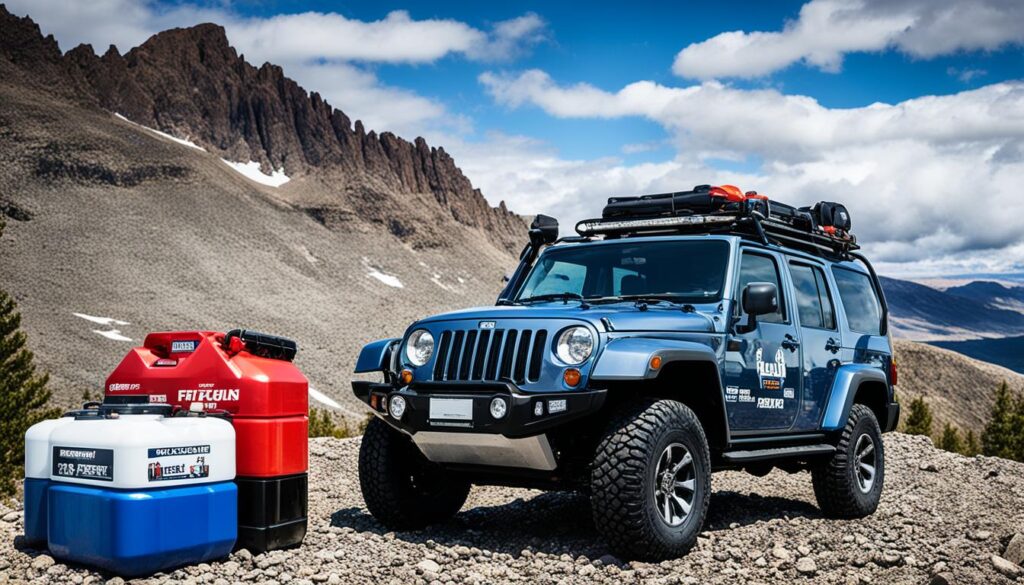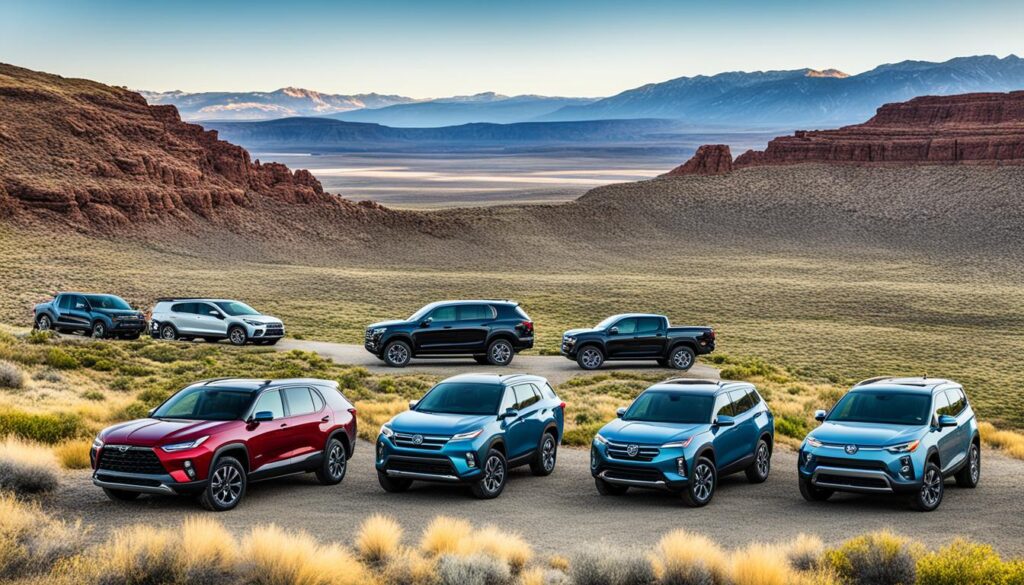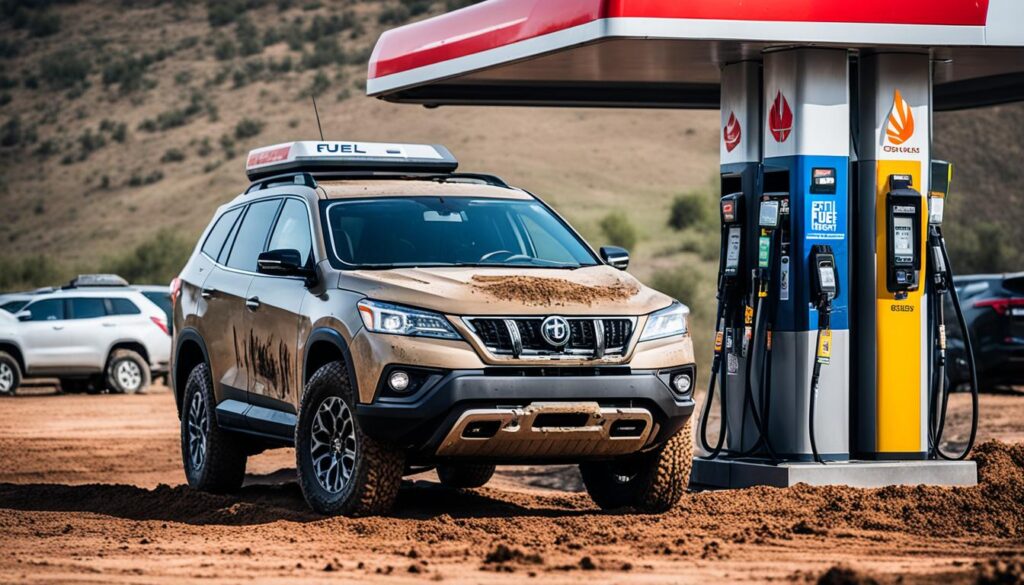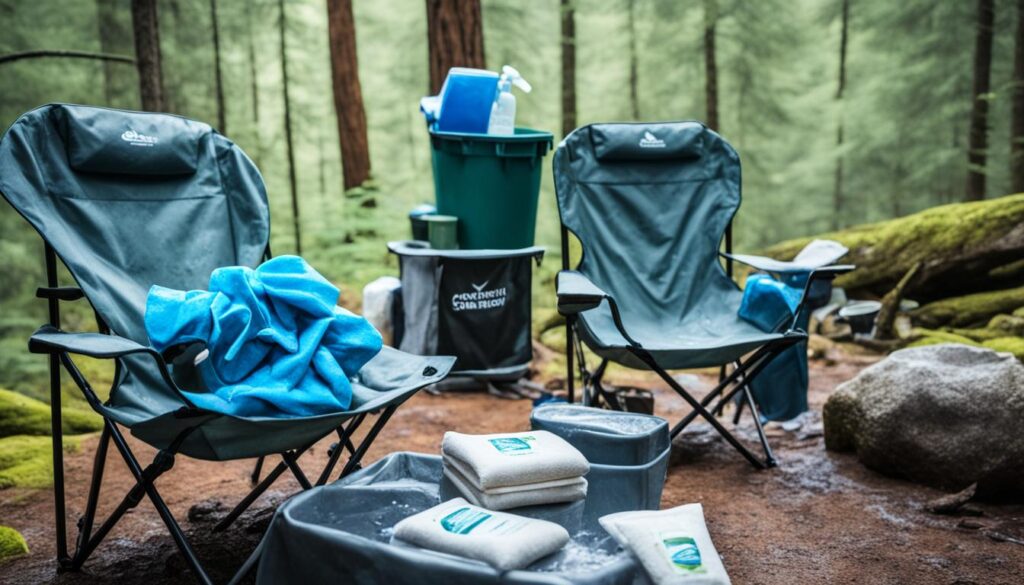Are you ready to embark on an unforgettable overlanding adventure? From the rugged terrains of the mountains to the vast stretches of deserts, overlanding allows you to explore the world off the beaten path. But before you set off, have you considered the best fuel choices to keep your journey running smoothly?
Overlanding requires careful consideration of the fuel options available to sustain your off-road adventures. Whether you’re traversing remote landscapes or tackling challenging terrain, choosing the right fuel is essential for optimizing performance, efficiency, and reliability.
But with so many options out there, how do you know which fuel is the best for your overlanding needs? Is it gasoline, diesel, or electricity? And what about the efficiency of the fuel you choose? Is there a more efficient option that can save you money while minimizing your impact on the environment?
In this article, I will delve into the world of overlanding fuel choices, exploring the pros and cons of each option and revealing the top fuel choices for your off-road adventures. Get ready to challenge common beliefs and learn about the most efficient and reliable fuel options that will enhance your overlanding experiences.
Key Takeaways:
- Choosing the right fuel is crucial for optimal performance and reliability during overlanding adventures.
- Gasoline, diesel, and electricity are the most common fuel options for overlanding.
- Proper fuel storage in safe containers is essential for transporting extra fuel during your journey.
- Fuel efficiency and environmental impact should be considered when selecting the best fuel for overlanding.
- Stay tuned to discover the top fuel choices and fuel container options for your off-road adventures.
Contents
Fuel Containers for Overlanding
When embarking on overlanding adventures, it’s essential to have reliable fuel containers to ensure a safe and steady supply of fuel throughout your journey. Whether you’re traveling in a camper van, off-road vehicle, motorcycle, or any other mode of transport, having the right fuel containers is crucial. In this section, we will explore various options for fuel containers that are specifically designed for overlanding, providing convenience, durability, and peace of mind.
Gas Cans and Jerry Cans
Gas cans, also known as jerry cans, are the most common and widely used containers for overlanding. These cans have stood the test of time and are known for their sturdiness and reliability. When choosing gas cans for overlanding, it’s important to select ones that meet safety specifications and regulations. Look for gas cans made of metal or high-quality polyethylene construction, featuring flame arresters, self-closing lids, pressure relief, and leak testing mechanisms. Approved Type I and Type II gas cans are ideal for overlanding, with Type II cans allowing for faster fuel dispensing.
Rotopax Gas Cans
An innovative option for overlanding fuel storage is Rotopax gas cans. These containers are made from high-strength plastic and are designed to be securely mounted and stacked, allowing for easy expansion of fuel capacity. The unique design of Rotopax gas cans ensures durability and prevents leaks, making them ideal for rugged off-road conditions. With Rotopax gas cans, you can safely carry additional fuel without sacrificing valuable storage space in your vehicle.
Front Runner Fuel Containers
Front Runner offers a range of fuel containers specifically designed for overlanding. These containers feature internal breathers to prevent fuel spillage during rough terrain and splash-proof pouring spouts for easy and efficient fuel transfer. Front Runner fuel containers are constructed from durable materials, ensuring long-lasting performance even in the harshest environments. With their practical design and reliable construction, Front Runner fuel containers are a popular choice among overlanders.
MSR Fuel Bottles
For adventure motorcycle riders, MSR fuel bottles are a preferred choice. These bottles are made from lightweight yet rugged materials, ensuring durability while minimizing weight and bulk. MSR fuel bottles boast an all-steel construction, making them resistant to punctures and leaks. They are also compatible with standard fuel stove supply connection caps, providing versatility for outdoor cooking needs. With MSR fuel bottles, motorcycle overlanders can enjoy peace of mind knowing that they have a reliable and efficient fuel storage solution.
Desert Fox Fuel Bladders
Desert Fox fuel bladders offer larger fuel capacities and are specifically designed to be mounted on motorcycles. These bladders are made from high-quality materials that are resistant to punctures and leaks, ensuring safe fuel storage during off-road adventures. Desert Fox fuel bladders feature secure mounting systems that keep the bladder in place, preventing movement and potential damage. With their innovative design, Desert Fox fuel bladders provide a practical and efficient way to carry extra fuel on motorcycles.

| Fuel Container | Description |
|---|---|
| Gas Cans/Jerry Cans | Durable containers made of metal or polyethylene construction, featuring safety mechanisms such as flame arresters and self-closing lids. Available in Type I and Type II, with Type II allowing for faster dispensing. |
| Rotopax Gas Cans | High-strength plastic containers that can be securely mounted and stacked for expanding fuel capacity. Designed for durability and leak prevention. |
| Front Runner Fuel Containers | Fuel containers with internal breathers and splash-proof pouring spouts. Constructed from durable materials for reliable performance in challenging environments. |
| MSR Fuel Bottles | Lightweight yet rugged fuel bottles made from all-steel construction. Compatible with standard fuel stove supply connection caps. |
| Desert Fox Fuel Bladders | Larger capacity fuel bladders designed specifically for mounting on motorcycles. Made from puncture and leak-resistant materials with secure mounting systems. |
Fuel Planning for Overlanding Trips
Proper fuel planning is essential for successful overlanding trips. Whether embarking on a thrilling off-road adventure or a long-distance expedition, considering fuel requirements is crucial. Effective fuel planning involves assessing factors such as:
- Distance between gas stations
- Vehicle’s maximum range
- Buffer fuel for unforeseen circumstances
- Riskiness of the route
By taking these factors into account, overlanders can ensure they have enough fuel to reach their destinations and overcome any unexpected challenges along the way. Fuel range calculations and fuel consumption ratings provided by reputable natural resources organizations can assist in making accurate estimations. These calculations often consider factors such as gas mileage, CO2 emissions, and fuel cost per year, helping overlanders make informed decisions when selecting the right fuel for their journeys.
Example Calculation for Fuel Range:
Let’s say my vehicle has an average gas mileage of 10 liters per 100 kilometers and a fuel tank capacity of 50 liters. I plan to travel to a remote location where gas stations are limited. Based on my research, the distance between the last gas station and my destination is approximately 500 kilometers.
To calculate how much additional fuel I need to carry, I’ll use the following formula:
Additional Fuel = (Distance / Gas Mileage) – Tank Capacity
Using the given example:
Additional Fuel = (500 km / 10 liters per 100 km) – 50 liters
This equation yields a result of 0 liters, indicating that no extra fuel is required. However, I may choose to carry a small reserve amount for safety purposes, depending on the riskiness and remoteness of the route.
| Factor | Considerations |
|---|---|
| Distance between gas stations | Avoid running out of fuel in remote areas with limited fuel stations |
| Vehicle’s maximum range | Determine the distance your vehicle can travel on a full tank of fuel |
| Buffer fuel for unforeseen circumstances | Carry extra fuel to account for detours, road closures, or unexpected delays |
| Riskiness of the route | Assess the route’s difficulty level and potential challenges |
By carefully considering these fuel planning factors, overlanders can embark on their adventures confidently, knowing they have accounted for their fuel needs. Remember, safety should always be a top priority when venturing into remote and challenging terrains.
Fuel-Efficient Vehicles for Overlanding
When embarking on overlanding adventures, having a fuel-efficient vehicle is essential for maximizing mileage and minimizing fuel consumption. Here are some top options to consider:
Ford Escape Hybrid
The Ford Escape Titanium Hybrid is a versatile SUV that offers both power and efficiency. With an average fuel economy of 5.9 L/100 km and a CO2 output of 139 g/km, it combines performance with eco-consciousness.
Toyota RAV4 Hybrid
The Toyota RAV4 Hybrid is a popular choice among overlanders. With all-wheel drive, 219 horsepower, and an average fuel economy of 6.0 L/100 km, it provides the perfect balance of capability and efficiency for off-road adventures.
Mitsubishi Outlander PHEV
The Mitsubishi Outlander PHEV is a plug-in hybrid electric SUV that offers the best of both worlds. It has an electric range of 35 kilometers and a gas-electric hybrid mode for extended trips, making it a reliable and fuel-efficient choice.
Honda CR-V AWD
The Honda CR-V AWD is a practical and adventure-ready SUV. With its ground clearance and turbocharged engine, it offers both versatility and performance. Its fuel efficiency adds to its appeal for overlanding trips.
Subaru Crosstrek
The Subaru Crosstrek is a popular choice among outdoor enthusiasts for its ample ground clearance and fuel efficiency. It strikes a balance between capability and economy, making it a reliable companion for overlanding adventures.
Chevrolet Silverado 1500 Diesel
For those who prefer a pickup truck for overlanding, the Chevrolet Silverado 1500 Diesel offers power and fuel economy. With a towing capacity of up to 4,200 kilograms and an average fuel economy of 8.9 L/100 km, it provides the necessary capabilities for off-road exploration.
When choosing a fuel-efficient vehicle for overlanding, consider the specific needs of your adventure and prioritize a balance between efficiency, power, and capability. Finding the right vehicle will enhance your overland experience while minimizing your environmental impact.

| Vehicle | Average Fuel Economy (L/100 km) | CO2 Output (g/km) |
|---|---|---|
| Ford Escape Hybrid | 5.9 | 139 |
| Toyota RAV4 Hybrid | 6.0 | N/A |
| Mitsubishi Outlander PHEV | N/A | N/A |
| Honda CR-V AWD | N/A | N/A |
| Subaru Crosstrek | N/A | N/A |
| Chevrolet Silverado 1500 Diesel | 8.9 | N/A |
Conclusion
Choosing the right fuel and fuel storage options is crucial for a successful overlanding adventure. When selecting a fuel-efficient vehicle, factors such as fuel mileage, CO2 emissions, and fuel cost per year should be considered. It is important to plan fuel consumption and estimate the distance between gas stations, especially for long journeys.
Carrying extra fuel is vital to ensure a buffer for unexpected situations and to maintain fuel availability in remote areas. Utilizing reliable fuel containers, such as gas cans, jerry cans, Rotopax gas cans, and fuel bottles, allows overlanders to transport and store extra fuel safely. These containers come in various sizes and designs to accommodate different overlanding needs.
By making the right fuel choices and opting for fuel-efficient vehicles, overlanding adventures can be optimized for both performance and sustainability. It is important to prioritize fuel efficiency and minimize carbon emissions to contribute to a cleaner environment. With proper fuel planning and strategic fuel storage, overlanders can embark on unforgettable journeys with peace of mind.
FAQ
What are the best fuel choices for overlanding adventures?
The most common fuel options for overlanding include gasoline, diesel, and electricity. The choice of fuel depends on the vehicle and personal preference.
What are the options for fuel storage containers for overlanding?
Popular fuel container options for overlanding include gas cans, jerry cans, Rotopax gas cans, Front Runner fuel containers, MSR fuel bottles, and Desert Fox fuel bladders.
How should I plan for fuel during overlanding trips?
It is essential to consider factors such as the distance between gas stations, the vehicle’s maximum range, buffer fuel for unforeseen circumstances, and the riskiness of the route. Fuel range calculators and fuel consumption ratings can help with fuel planning.
Can you recommend any fuel-efficient vehicles for overlanding?
Some fuel-efficient vehicles suitable for overlanding include the Ford Escape Hybrid, Toyota RAV4 Hybrid, Mitsubishi Outlander PHEV, Honda CR-V AWD, Subaru Crosstrek, and Chevrolet Silverado 1500 Diesel.
How can I optimize fuel choices for my overlanding adventure?
By considering factors such as fuel mileage, CO2 emissions, and fuel cost per year, you can choose the best fuel-efficient vehicle for your overlanding adventure.






